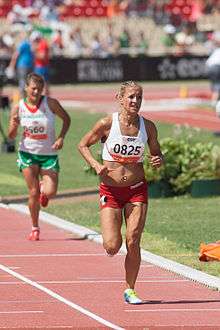T20 (classification)

T20 is a disability sport classification for disability athletics in track and jump events. It broadly covers athletes with intellectual disabilities.
Sport
This classification is for disability athletics.[1] This classification broadly covers athletes with intellectual disabilities.[2] The classification by Buckley goes on to say "To become eligible to compete in the Paralympic Games, all athletes with an Intellectual Disability have to reach the primary eligibility criteria, which is determined by:
- An IQ score at or below 75 (when IQ 100 is the score of the average person)
- Significant limitations in adaptive behaviour (conceptual, social or practical adaptive skills) [Examples may include: communication, self care, social skills, home living, health and safety]
- Onset acquired before the age of 18"[1]
The International Paralympic Committee defined this classification on their website in July 2016 as, "(Intellectual impairment)".[3]
Performance and rules
People in this class are required to use blocks for races 400 meters or less. They can be provided assistance in setting up their blocks if they make a request in advance.[4]
Events
Internationally, events open to this class include the long jump, shot put, 400 meters and 1,500 meters. There may be more events on the national level at the discretion of the national track federation.[4]
| Gender | Event | Class | AQS/MQS | BQS | Event |
|---|---|---|---|---|---|
| Men's | 400 m | T20 | 49.2 | 50.46 | 2016 Summer Paralympics |
| Women's | 400 m | T20 | 60.27 | 61.59 | 2016 Summer Paralympics |
| Men's | 1500 m | T20 | 03:58.2 | 04:00.9 | 2016 Summer Paralympics |
| Women's | 1500 m | T20 | 04:40.0 | 04:50.0 | 2016 Summer Paralympics |
| Men's | Long jump | T20 | 7.11 | 6.74 | 2016 Summer Paralympics |
| Women's | Long jump | T20 | 5.19 | 5.03 | 2016 Summer Paralympics |
History
The classification was created by the International Paralympic Committee and has roots in a 2003 attempt to address "the overall objective to support and co-ordinate the ongoing development of accurate, reliable, consistent and credible sport focused classification systems and their implementation."[5]
Competitors
Competitors in this class include José Antonio Expósito and José Martínez Morote from Spain, Peyman Nasiri Bazanjani from Iran, and Daniel Pek, Barbara Niewiedzial, Karolina Kucharczyk, and Arleta Meloch from Poland.
See also
- Para-athletics classification
- Athletics at the Summer Paralympics
- S14, the classification for intellectual disabilities in swimming.
References
- 1 2 Buckley, Jane (2011). "Understanding Classification: A Guide to the Classification Systems used in Paralympic Sports". Retrieved 12 November 2011.
- ↑ "Summer Sports » Athletics". Australia: Australian Paralympic Committee. Retrieved 19 November 2011.
- ↑ "IPC Athletics Classification & Categories". www.paralympic.org. Retrieved 2016-07-22.
- 1 2 "PARALYMPIC TRACK & FIELD: Officials Training" (PDF). USOC. United States Olympic Committee. December 11, 2013. Retrieved August 6, 2016.
- ↑ "Paralympic Classification Today". International Paralympic Committee. 22 April 2010. p. 3.
.svg.png)
